 ST. CASIMIR'S AT NORTHEIM
NEWTON TOWNSHIP, MANITOWOC CO., WISCONSIN
ST. CASIMIR'S AT NORTHEIM
NEWTON TOWNSHIP, MANITOWOC CO., WISCONSIN ST. CASIMIR'S AT NORTHEIM
NEWTON TOWNSHIP, MANITOWOC CO., WISCONSIN
ST. CASIMIR'S AT NORTHEIM
NEWTON TOWNSHIP, MANITOWOC CO., WISCONSIN
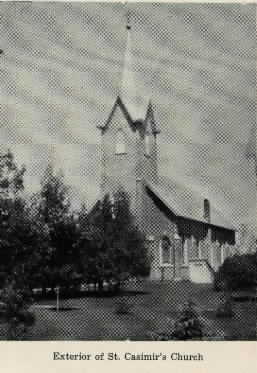
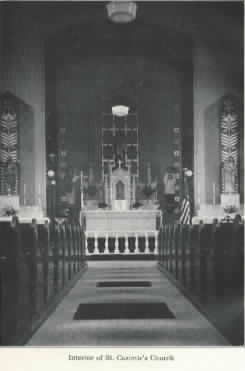
Chapter I A Brief Historical Sketch of St. Casimir's Congregation of Northeim, Wisconsin. St. Casimir's Congregation at Northeim, Wisconsin according to all reliable sources* is the fourth oldest Polish Catholic parish in the State of Wisconsin. *("The Catholic Church in Wisconsin", published by T.J. Sullivan, Milwaukee, Wis., 1895 - 1898, under the auspices of the Catholic Hierarchy in Wisconsin. - St. Casimir's Congregation in Northeim, however, is described there in a cursory way up to 1898. Just a general historical sketch is found there, with a few dates concerning the organization of the congregation and a list of the priests who had charge of this parish up to that date; quite many of the Polish names of these priests, however, are spelled erroneously. We are giving the correct spelling of all these names as found in the Church Records.) It is located inland off the shores of Lake Michigan, one half mile north of the village of Northeim, and one and one half miles northeast of Newton RR. Station, and seven miles south of the city of Manitowoc. Heretofore, nobody as yet attempted to write a historical sketch of this parish; at least, as far as the author investigated, he did not come across any historical fragments of this kind; neither did he find any ready-made historical notes on this matter. The assumed task, then, to write a reliable and brief HISTORICAL SKETCH OF ST. CASIMIR'S CONGREGATION OF NORTHEIM, is connected with more than one or two difficulties. In order to do justice to all parties concerned in this HISTORICAL SKETCH, we must strictly adhere to the general rules of writing a critical history; "The historian should not dare to say something false, nor should he refrain from telling the truth"* *(Cicero. De orat., 11,15, repeated by Pope Leo XIII, ep. "De Studiis" etc., as in manuscript) In view of this fundamental principle, then, all the historical facts herein adduced will be based on reliable sources, having reference to St. Casimir's Congregation at Northeim, Wisconsin, whether ecclesiastical* or civil in character.** We shall also be guided by the still existent old Church Records (Baptismal, Marriage, and Burial) ***, and finally, by a genuine and uncontested oral tradition of the old pioneers, some of whom are still alive and in fact quite often like to tell some of those reminiscences to their grandchildren. In fact, all history comes down to us by oral tradition.**** *(several official documents issued by the diocesan authorities in behalf of this Congregation, especially the transfers of the respective Pastors; also the Annual Reports forwarded to the Diocesan Chancery Office.) **( Recorded DEEDS in behalf of St. Casimir's Congregation). ***(All these Church Records are still well preserved; some of them have been recently bound anew ****(The authors of this History took great pains in gathering all reliable facts concerning St. Casimir's Congregation from several trustworthy men, born and brought up at Northeim, so as to publish a genuine and critical History of St. Casimir's Congregation.). Art. 1 ORIGIN AND DEVELOPMENT OF NORTHEIM There is nothing definite in history about the early beginning of our present Northeim; neither is there a trace to tell us the reason why this name had been chosen in preference to another. As the etymology suggests, it seems to be rather of a German origin. Most probably some of the very first settlers in this part of the country were Germans, and for this reason called our present locality by that name. In any event, up to the year 1860, this small place of ours seems not to have been so very important as to designate it at least with a small dot on the map of Wisconsin. >From Kruszka,"Polish History in America", however, we quote the following item about Northeim: "As early as 1861, Polish immigrants began to settle and make their homes in the primeval forests among the Indians in that locality which today is called Northeim. They purchased small parcels of land with the blessed hope that this good soil would provide their daily bread. In the course of time, these very first pioneers induced their friends and relatives, who were either in this country already, or yet abroad, to come and join them in their new habitat in order to bring about a more congenial and more pleasant environment to live in" * Thus before long, this entire vicinity along the shores of Lake Michigan became densely populated. In time, these thrifty people acquired some more land in order to enlarge their original possession. The difficulty, however, as a rule with all first settlers, was to first clear the land of brush and timber in order to put it under cultivation. Timber and log of various species was plentiful. Logging was done on a big scale. There were the "Northeim Centerville Piers", from which lumber and logs were shipped to various points. The situation looked very hopeful, because from these financial sources they could realize some cash or at least a barter for which they could secure the necessary farm-implements with which to till the soil. * (The author of this History is the Rev. Venceslaus Kruszka, who published it under the title: "Historyn Polska w Americe", Milwaukee, Wis., 1906. Hereafter we shall cite it "Kruszka, Polish History in America". - See vol. VII, pp.84-89, where the author repeats the same items as found in "The Catholic Church in Wisconsin", supplementing them with additional minor information up to the year 1906.) Not contented with bread alone, these pioneers sought something more sublime. As progress was made in essential contingencies of the material part of life, they also gave thought about the Supreme Giver from whom all good things come. They realized that a suitable place of God's worship in their midst was still lacking in order to make this place what it should be. It is true, that God is everywhere, but these pious people also knew that they should provide for a suitable place where they all could meet and worship God in a fitting manner. This heartfelt desire was discussed quite frequently whenever they came together for some kind of social meeting. And this noble aspiration became in the course of time a blessed reality. The popular tradition has it *that at a christening-party for Frank Leszcz, the son of John Leszcz, the idea was conceived to organize a congregation of their own, and erect a tiny church for the start. Being pious Catholics, they knew very well that, having a suitable place for celebrating the holy sacrifice of the Mass, they could implore a more abundant God's blessing upon themselves and the entire locality. * Corroborated again by reliable and several old parishioners Art. 2 HISTORICAL FACTS ABOUT ST. CASIMIR'S CONGREGATION St. Casimir's Congregation was organized in the year 1868. The exact date, however, on which the people held a meeting for the purpose of starting a separate church and organizing a parish of their own, cannot be definitely established. The first baptism registered in the Baptismal Records bears the date of May 21, 1868. It reads: "On May 21, 1868, I baptized Elizabeth, born April 20th, the daughter of Peter and Mary Brachman. The sponsors were: John Hieps and Elisabeth Sheer". (Signed) Rev. Bonaventure Buczynski, Pastor. * * (An English translation from the original Latin Record) There is,however, no other historical indication that this baptism was administered already in some kind of temporary church at Northeim. In those days, the priests had the permission to use private houses as centers for divine worship, said Mass occasionally and administered the Sacraments to the aged and sick people who could not go to the neighboring churches, due to bad roads and lack of transportation. A team of oxen, owned by a farmer, was considered in those days a big fortune; a team of horses and some kind of light four-wheeled carriage was looked upon as the property of a well established landlord and a leading man in the community. The oldest civil Records, a registered DEED * , shows that Ignatz Ramion and John Krysiak deeded a parcel of land for church purposes, altogether 3 acres of land **. It was on this piece of land, that a tiny framed- building was erected, known as the first Catholic church of Northeim. * (It reads: "This Deed is given to correct a Deed formerly executed by Ignatz Ramion and wife and Antonia and Lorenz Swokowski to the party of the second part hereto OCT. 16, 1866 recorded in vol. 8 of Deeds on page 47.p, in which said the Deed the track of land included to be conveyed were described wrong and this is given to correct the same and annul the former Deed and Lorenz Swokowski and wife have since deeded to John Ramion..." The following described real estate situated in the county of Manitowoc and State of Wisconsin to wit: One and one half acres of land of West half of North West quarter of Section No. Twenty five (25) in Township No. Eighteen (18) North of Range No. Twenty three (23) East and also One and One half acres of land in the North West quarter of the South West quarter of said Section No. Twenty five (25) of said township and Range." (Signed) Ignatz Ramion Anna (X her mark) Ramion Jan Krysiak Johanna (X her mark) Krysiak Signed, Sealed and Delivered in Presence of John Franz Elisa Franz Received for record at 3 o'clock P.M. December 4, 1875 John Franz, Register) ** (As it appears from the foregoing document, Ignatz Ramion and his wife and John Krysiak and his wife deeded each 1 1/2 acres of land for church purposes as early as Oct 16, 1866. About one half of this land is used as an adjacent cemetery of this parish. The rest of the land is used as church premises. Situated rather on a hilly site, it forms a fine church property admired even today by visitors.) 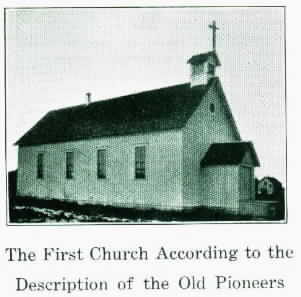
As the picture shows, this edifice did not differ much from the rest of the nearby farm-houses. Just a wooden cross, made out of two pieces of hewn board, placed on the front gable, made it as a distinctive sign of the house of God. According to all reliable reports, supported by the still existent Church Records, the people had only occasional services in this church, attended to by the priest who also later served St. Mary's church at Manitowoc. Due to the scarcity of priests at that time, the people of a newly organized parish had to be satisfied with occasional services only when a visiting priest came through this part of the country. Quite frequently, in later years, on Sundays and holydays of obligation, our pioneers came to St. Mary's church at Manitowoc, where the people were more numerous, had more opportunity to earn better wages in the sawmills, some small factories already existing, and for this reason could afford to have a more steady priest in their midst, as well as regular divine services. We cannot overlook the historical fact, that up to March 3, 1868, all Wisconsin belonged to the diocese of Milwaukee, having only one Bishop and some thirty-four priests to cover the entire territory and arrange occasional services for the Catholic people and the various scattered communities. * * ("The Oldest Catholic Church In Wisconsin.", pp. 460-461: "The parish of St. Boniface, a mixed congregation of German and Irish, was established at Manitowoc, Wis. in 1853, and on March 15 of the same year the Rev. H. J. Nuyts, S.S. Crucis, began erecting a small frame church." - It was therefore, also this tiny first church to which our people of Northeim belonged. For this reason we have to search for the oldest records of baptisms, marriages and funerals of our people of Northeim in St. Boniface Church.) There were no concrete highways as yet; not even passable gravel roads. A mere cut through the dense woods and underbrush, along a former Indian trail, part of which was quite often a poor combination of half-rotten logs, stumps and rocks in between, these were the former highways; there was no railroad transportation as yet. The quickest way of getting from one community to another was only on horseback, or paddling a crude home- made canoe on the waterways, connecting the then populated places. But even this kind of transportation was hampered by the abundant snowdrifts on land, and thick ice of the waterways during the long winter months at that time in Wisconsin. Besides these inconveniences of travel, a priest at that time was appointed as pastor at large for several smaller Catholic communities which today form one or even two counties in Wisconsin. * * (Up to 1868, v.g. the present Cathedral parish of Green Bay extended North as far as the boundary line of Upper Michigan; East as far as the shores of Lake Michigan; South as far as Milwaukee County, and West as far as the present boundaries of the State of Wisconsin.) This historical incident, then, will explain to the reader the reason why St. Casimir's congregation was quite often deprived of a permanent pastor. (* Denotes a footnote which will be shown at the end of the paragraph in parenthesis) Art. III CHARTER MEMBERS OF ST. CASIMIR CONGREGATION The present generation of our community will be interested, we believe, to see the names of their grandfathers or relatives, figuring on the original list * as charter-members of our congregation. *(Old Record Book No. 1 of St. Casimir's Church, Northeim. Although somewhat eaten up by bookworms, it is still preserved and legible.) They are: Drobka, Stanley Grzeca, Ignace Mrotek, Francis Grzeca, Adam Kadow, Stephen Szweda, Joseph Klien, Nicolaus Leszcz, John Swakowski, M. Bonk, Thomas Satowski, John Zywert, Lawrence Malicki, Adam Rybarczyk, Peter Stefaniak, Martin Kortas, Michael Niespodziany, Val. Lipski, Joseph Blaszka, Joseph Zych, Anton Krysiak, John Rybarczyk, Jacob Cerkwicki, Frank Buholt, Ignatius Ramion, Ignace (these dates are penciled in next to the name - 1804-1898) Bonk, John Wnuk, Bartholomew Daron, Frank Kuffel, Frank Bonk, Andrew Radzinski, Andrew Sitkiewicz, Felix Gaca, Ignace Szukalski, Paul Dabrowski, Joseph Szuminski, Mathias Blaszka, Casimir Donarski, Joseph Lachowski, M. Szlapa, Joseph Kapruszczynski, Stanley Osik, John Mindak, Ignace Wanderski, John Najlec, Peter Dominowski, Theo. Osik, Martin Lipski, Nicolaus Fruzyna, Thomas Bucbanowski, Stanley Bonk, Xavier Zych, Philip Cichy, Albert Cichy, John Glomski, Anton Tomczyk, Valentine Jagodzinski, Joseph Gunter, John Wadzinski, Simon Szweda, Joseph, Secretary (* Denotes a footnote which will be shown at the end of the paragraph in parenthesis) CHAPTER II SPECIAL HISTORICAL EVENTS Of Interest To The Parishioners Of Northeim From 1868 To 1943 All history is interesting, because as Cicero defines it: "History is the witness of time, the light of truth, the memory of life, and a teacher of life." * History tells us how people of other times lived; how they battled for home and their existence; what culture they possessed; what struggles they had to make for the upkeep of their homes and families; what they believed in; what works of culture and education they erected in their communities; and finally what lasting achievement was theirs. ** * (Cicero. De orat., II, 15) ** Diedrich-Gehl, "History of Clintonville", p. 1) While compiling the history of St. Casimir's parish at Northeim we cannot overlook the principal historical facts: religious, political, commercial and social, which are so intimately connected with the growth of the community in this great country of opportunities. Northeim always had, and today possesses some of those outstanding marks which make it a friendly peace-loving community. Our HISTORICAL SKETCH of ST. CASIMIR'S CONGREGATION would be barren and deprived of historical interest without mentioning at least some of the special events which occurred in the long interval of the last seventy-five years. ART. I All writers of various creeds agree that even a small, tiny country church inspires new life into the hearts of the worshippers who in any way help in erecting it. Quite often, it is only with a great sacrifice that a small band of pioneers can afford to build a church. They look upon a tiny country church as the most fitting place to worship God, the Giver of all things, according to the dictates of their hearts. They are only too glad to meet together on Sundays in order to praise the Lord, to assist at Holy Mass, and to listen to a priest's sermon. They are given thus an opportunity to forget for a few hours about their daily work and their hardships of daily family life. It is also Sunday, when people from the entire district meet their relatives, friends and make new acquaintances with some newly arrived settlers. The divine services are finished; yet, the parishioners are not in a particular hurry to go home. Especially on a bright and warm Sunday, there we see a group of men, talking about the growth of the crop; over there, we see John, Joe, Elmer and several others of their friends in a lively discussion about politics. Down in the basement of the church, the mothers and young ladies of the parish are holding their scheduled meetings, paying their monthly or quarterly society's dues, planning for a parish social or a bazaar etc. * * (This trend of parish-social life even today prevails in most of the country parishes; at least, it is still kept up at Northeim.) It is the church which gathers the people on Sundays together and makes out of them one well organized parochial family. In fact, it is the church which becomes a center of religious, social and community activities. This was also the trend of life and happiness of our early pioneers at St. Casimir's parish. For twelve long years,they came to their first erected church. Although it was tiny and of a humble construction, being only a frame-structure, yet, every year they made some improvements within and outside, in order to make it a fitting house of God. On July 21, 1880, however, their heartfelt joy turned into a deep sorrow. Their beloved church was destroyed by fire. This loss crippled the entire congregation and its community-life for some time. * * Kruszka, "Polish History in America", vol VII, p. 89 Art II THE ERECTION OF A NEW CHURCH 1880-1881 For nearly one year, the parishioners of Northeim were deprived of a church. Divine services, however, on Sundays were held in the parish school house. The oral tradition is supported by the historical fact: The Church-Records show a continuance of two priests among these good people of Northeim. The Revs. J. Musielewicz and Arnetus Goch administered several baptisms, and burials during this interval, as proven by their signatures in the respective Records. * *(This is also corroborated by oral tradition of the old parishioners who were then in their "teens".) The parishioners felt keenly the loss of their first church. But come what may, they had borne patiently the burden of the day. Never depressed in spirit and sacrifice, they held a parish meeting on the third Sunday after the fire, that is, on August 18, 1880, for the express purpose of erecting a new and larger church. In the meantime they had ample time to discuss among themselves in private gatherings at their homes what kind of an edifice they contemplated to erect, how much each family should or could contribute towards the building-fund, how much and what work precisely could be performed by the people themselves in the form of a free contribution by each farmer etc. When the appointed day for a special parish meeting arrived, there was a unanimous vote to erect a new brick church 70 x 40 feet, with a steeple 80 feet high. A special building committee was selected with the instruction to solicit the necessary funds, to let the contracts, and to assist the pastor with the supervision of carrying out the plans. 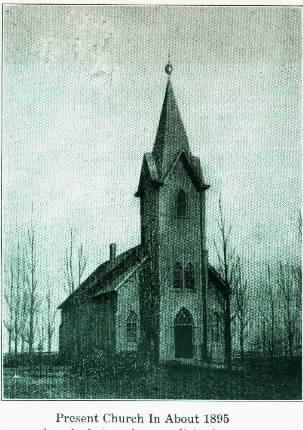
The exact cost of this structure is not known, because the major part of hand-labor, the hauling of the building material, much lumber, brick, stones and sand came as donations from the wealthier families. * * (According to our present rough figuring, this church would have cost at least some thirty thousand dollars. Even today it is one of the finest country churches, well preserved and solid.) The fragmentary Records also reveal that the majority of the families, then belonging to this congregation, had contributed a goodly sum of between $50.00 and $100.00 each in cash, which at that time was considered a fortune. Labor at that time was cheap, and money was hard to obtain. * * (Common labor was paid $1.00 per day; bricklayers and mechanics were paid $2.00 a day - The Records show that several parishioners paid in cash their assessment of $100.00 or $50.00 respectively. This incident convinces us what sacrifice our good people of Northeim made at that time in order to erect a fitting church.) The new church was completed somewhere around the middle of July , 1881, and dedicated by the Most Rev. M. Heiss, Archbishop of Milwaukee, to whose jurisdiction at that time Northeim and the entire county of Manitowoc belonged. * The popular tradition has it that the dedication of the church occurred during the harvest time. * ("The Catholic Church In Wisconsin", p. 493; Northeim and all county of Manitowoc remained within the boundaries of the Archdiocese of Milwaukee until May 3, 1905, when the Diocese of Superior was established. At that time the Green Bay Diocese lost some counties in the Northwest, but was reimbursed by the counties of Manitowoc, Oshkosh etc. in the southern portion.) It is also to be noted that at that time the congregation consisted of many more families than it ever did thereafter. In about the year 1895, there were forty-eight families on the Church Records, thirty-eight of whom were Polish and the rest German. This incident also explains why priests, attending this parish, had to know these two languages sufficiently in order to accommodate all the people. According to oral tradition, at one time this congregation numbered nearly twice as many families that is, between 1875 and 1890, after the new church had been erected and a parochial school had been opened. * But as time went on, many settlers disposed of their farms and moved away to the larger cities where thy earned more money and thus improved their living conditions. * ("The Catholic Church in Wisconsin." p. 493.) At present, the congregation consists of thirty-five contributing families.* * (According to the latest census taken by the present pastor just shortly before the Diamond Jubilee celebration.) Art. III ST CASIMIR'S PAROCHIAL SCHOOL Mention was made above about a larger number of parishioners and also about a parochial school at Northeim. Credit for this achievement must be given to the Rev. Simon Wieczorek, whose very efficient pastorate is recorded from Dec. 1, 1874 until January 16, 1877. It was he who erected a new and modern parsonage at Northeim. Upon the erection of a new priest's house, the former residence was remodeled and converted into a school house. At that time, according to a reliable historical source, published some 37 years ago,* it is stated that some eighty pupils attended this parish school. And due to the fact that by all statisticians one child per family gives us the approximate average of families of the respective locality, for this reason our statement above, concerning the number of about eighty families at that time belonging to St. Casimir's parish, is historically corroborated. Briefly, considering all the circumstances of time, persons and place, Northeim became within eight years from its foundation a well established, progressive and flourishing community. * (Krusczka, "Polish History in America," Vol. VII, p. 86, who quotes in behalf of his statement an old Almanac published in 1876, but without the place and name of the publishers.) 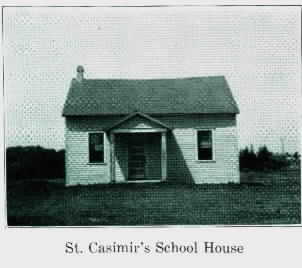 St. Casimir's school at Northeim was a blessed reality of the good and generous parishioners. They themselves were denied this God-given right of attending a free school, and receiving an opportune education in their homeland under the dictatorial rule of their oppressors. Most of them had to live through the religious persecutions at that time in Prussia and Russia. * With profound sorrow in their hearts, they preferred to leave their parents, their relatives, their properties and everything sacred to their memories, and migrate to a strange land, where they had to start anew to build their homes and raise their families, to work hard and toil in sweat and fatigue. Yet, this new land became for them a God-given land of the free, where everybody may worship God Almighty according to the dictates of his heart, where people may build their own churches and schools for making out of their children God-fearing and law-abiding citizens. * (See: Marx, J., "Lehrbuch der Kirchengeschichte," Trier, 1903, pp. 696-697: "Der preussusche Kulturkampf", pp. 723-725: Der Erzbishof Felinski von Warschau und mehrere andere Bischofe wurden verbannt, viele Priester eingekerkert and getotet, weil sie den verwundeten Polen geistlichen Beistand geleistet haben." Although a mixed congregation of Poles and Germans, nevertheless there was no trouble whatsoever, when there was a question about opening up a parish school, of supporting it, and sending their children to the same for a religious instruction. Even now, all the Catholic families although of diverse nationalities, live in peace and harmony, love their parish church, and support it according to their means. 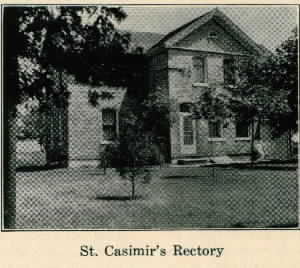 Art. IV. ST. CASIMIR'S SCHOOL A CENTER OF EDUCATION AND VARIOUS SOCIAL ACTIVITIES 1877 - 1890 The old parishioners of this place even today cherish blessed memories of their schooldays. As long as the people of this congregation were more numerous and able to support their own parish school, they gladly contributed towards its support, even with great sacrifice on their part. When, however, many families moved away, it was simply impossible to keep up their beloved school. There is no reliable record as to the exact time when St. Casimir's parish school ceased to exist. According to all indications, however, it must have been around the year 1900. The acting Rev. Pastor was the supervisor and principal of the school. It was part of his pastoral duties, with the assistance of his parish- committee, to procure the necessary fuel, utensils, furniture and all other items for the upkeep. * * (The old Records show explicit items bought for school purposes, but were paid for from the parish treasury without any extra assessment for the school. All parishioners, whether they sent children or not, contributed alike annual church dues in the sum of $16.00) It also was part of his pastoral duties to attend to the instruction of the children in branches pertaining to religion and history. The old people of today quite frequently commemorate with a great respect and love the name of Mr. Anthony Mallek, who for many years had been organist of the church, and at the same time also teacher in the parochial school. Education, music and singing flourished under his competent direction. Again, we find a distinguished mention in "The Polish History of America," in reference to the notable work and accomplishment of Mr. Mallek. We quote the following: "Anthony Mallek had organized a parish choir consisting of 40 members. He met with great success to the extent of developing the best church choir amongst the Polish immigrants in America. Nowhere in this country could a better rendition of Mass in Latin of the most famous composers be heard, except at Northeim. Each and every choir member was an accomplished singer." * * (See footnote 24 - Kruszcka, "Polish History in America.") The result of this painstaking training in music and singing still manifests itself today. Musical talent and melodious singing is found even today in many homes of our people, thus perpetuating the noble deeds of their forefathers in praising the Almighty during divine services. Even the younger generation of today enjoys community singing. And there are quite many more praiseworthy things to be said about the flourishing education, imparted to those young people, many years ago in Northeim. Our young people liked in those days to attend school and obtain all the possible education which a country school could offer. Boys and girls alike were anxious to make a complete course of eight grades. They were glad to help father and mother at home and on the farm; they stayed away from school for a few days in the spring and fall, when their help was needed to plant potatoes, cabbage etc., and in fall to gather crops. But they loved to return to school as soon as possible, notwithstanding their age and height. This explains the reason why Northeim was later well represented by professional men in practically all walks of life. CHAPTER III Art. 1 A CHRONOLOGICAL LIST OF PERMANENT PASTORS * * (In making out this chronological list of permanent pastors, only probable dates are given as found first in one of the Church Records, v.g. when the new pastor assisted at the first baptism, or marriage, or funeral. This method is the only way to furnish some kind of a most probable list with approximate dates.) (Handwritten here is the following: Josef Cichy buried in May 1867) 1. Rev. Bonaventure Buczynski, from May 21, 1868, until Oct. 15, 1870. 2. Rev. F. X. Kralczynskki, from Oct. 29, 1870, until May 8, 1872. 3. Rev. P. Koncz, from Aug. 11, 1872, until May 3, 1873. 4. Rev. A. Michnowski, from Aug. 25, 1873, until Dec. 1, 1874. 5. Rev. Simon Wieczorek, from Dec. 18, 1874, until Jan. 16, 1877. 6. Rev. Vincent Gieryk, from January 29, 1877, until Jan. 15, 1878. From January 15, 1878 until April 19, 1879, the following priests were in charge: 7. Rev. F. Fessler * (The initial "F." is as it appears in booklet) 8. Rev. C. Rogozinski 9. Rev. Hyacinth Gulski 10. Rev. A. Bukowski * ("The Catholic Church in Wisconsin," p. 460 and p. 1024 list the Rev. Joseph Fessler as pastor of St. Boniface Church, Manitowoc, from May 10, 1878. Being in ill health, he resigned from his former pastorate. It is probable that he took charge of Northeim for a few weeks around Easter, 1878, and thus his name appears on the Church Records of St. Casimir's congregation at Northeim.) From April 19, 1879, we again find the following steady pastors in charge of St. Casimir's Church: 10. Rev. J. Musielewicz, from April 19, 1879 until June 20, 1880. 12. Rev. Arnetus Goch, from Dec. 22, 1880, to June 26, 1881. 13. Rev. George Fessler, from June 30, 1881, to April 10, 1882 * 14. Rev. F. Orzechowski, from Aug. 7, 1882, to July 25, 1884. 15. Rev. J. Dutkiewicz, from Dec. 29, 1885, to January 12, 1887. 16. Rev. J. Horbaczewski, from Oct. 2, 1887, to June 25, 1888. 17. Rev. John Maczynski, from March 7, 1889, to April 26, 1891. 18. Rev. Z. Luczycki, from May 24, 1891, to January 16, 1893. 19. Rev. Henry Cichocki, from February 19, 1893 to May 18, 1893 ** 20. Rev. Ignace Paluch, from May 25, 1893, to Dec. 10, 1905. NOTE: On May 3, 1905, the entire county of Manitowoc became part of the Diocese of Green Bay. 21. Rev. F. Kupka, from Dec. 24, 1905, to March 10, 1906. * (The Rev. George Fessler, a younger brother to the Rev. Joseph Fessler, succeeded him in the pastorate at St. Boniface Church in Manitowoc. It seems that there was no Polish priest available at that time to take charge of Northeim, and for this reason, after vacating St. Boniface pastorate, he assumed that of Northeim. His name is also listed in "The Catholic Church in Wisconsin", pp. 460 and 1024.) ** (All these nineteen priests heretofore listed were refugees who escaped the "Ma'gesetze" of Bismarck in the kingdom of Prussia. The author had met several of these priests and listened to their stories how they managed to escape in disguise from the German police and made arrangements afterwards to reach the United States.) From March 10, 1906, to April 7, 1907, the congregation was without a resident priest. The services were held by various priests, commissioned to do so by the Most Rev. Bishop of Green Bay. We find the names of: Rev. J. Kulla, Rev. J. Kruszynski, the Franciscan Fathers of Pulaski, Wis., and the Capuchin Fathers of Appleton, Wis. From among the Franciscan Fathers of Pulaski, the names of Fathers: Jerome Schneider, Anthony Wisniewski, and Louis Kania appear quite frequently on the various Church records. From among the Capuchins, the names of Fathers: Cassian Bugart and Lucas Rasch occur. 24. Rev. E. Magott, from April 7, 1907, until April 4, 1907 25. Rev. F. Kroll, from March 12, 1908, until July 18, 1908. 26. Rev. Pachoski, from October 1908, until February 28, 1909. 27. Rev. Paul Sokol, from March 13, 1910, till April 30, 1911. From April 30, 1911, after the departure of Father Sokol, the parish again was without a resident pastor. The people, however, had regular services attended by the Franciscan Fathers of Pulaski, and the Salvatorian Fathers of St. Nazianz. On the pages of the various Church Records again appear the names of: Father Sturmius Heartl, Father Raphael Wittig, Father Epiphanius Deibele, and Fintanus Holzknecht. 28. Rev. Stanislaus Lapinski, from Sept. 6, 1914, until May 21, 1916. 29. Rev. Ignace Grad, from November 15, 1916, until October 15, 1919. 30. Rev. Peter Novitske, from Oct. 20, 1919, till Sept. 1921. 31. Rev. Dominic Szopinski, from Sept., 1921, to January, 1928. 32. Rev. Florian Marmurowicz, from Jan., 1928, to May, 1928. 33. Rev. Paul Sokol, from July, 1928, to Oct., 1928 (second time) 34. Rev. Joseph Weiss, from Nov., 1928, to Sept., 1931. 35. Rev. Michael Wasniewski, from Sept., 1931, to April, 1934. 36. Rev. Stanislaus Ziolkowski, from April, 1934, to Oct., 1937. 37. Rev. Ignace Grad (second time), from Oct. 1937, to April 1939. 38. Rev. Anthony Betley, from June 15, 1939, up to the present day. ART. 2 - SPECIAL HISTORICAL NOTES Concerning the Various Activities of the Former Pastors in Behalf of St. Casimir's Parish At Northeim A serious attempt has been made by the author of this History to collect all possible data concerning the activities and noble deeds of all the previous Pastors in behalf of this Congregation. Due to the fact, however, that quite many of them stayed only for a short interval at Northeim, and due also to the fact that they did not keep a Diary or Historical Notes concerning their activities during their sojourn here, nothing more can be said about them, than placing their names in the chronological order on the list of succession. There is no doubt that quite many of them did not contemplate to stay here long; thus they were merely satisfied with the performance of their usual pastoral duties. * * (Most of these former pastors of Northeim are listed as organizers of Polish parishes in Milwaukee. See: "The Catholic Church In Wisconsin", pp. 1173-1181. Personal Index.) It is also a pity that, even after many inquiries, we were not able to obtain photographs of all these hard-working pioneer priests at Northeim. The author of this History went into the trouble to contact all the former Pastors of Northeim, still alive, in order to offer to the present generation a complete history of this Congregation. He also contacted the oldest parishioners in order to obtain from them reliable information to this effect. Whatever information he could obtain, he then pieced together and scrupulously compared it with all the existent Records of St. Casimir's Congregation, thus offering to the readers a genuine and critical apocalypse of the outstanding former Pastors at Northeim. It is also noteworthy to add that several of these pioneer priests came from their fatherland directly to Northeim, accompanied by their relatives and friends, in order to escape the religious persecution in Prussia, inaugurated by Bismarck, and thus seeking a God-given liberty of conscience, religion, and personal property.* * (Marx, J., "Kirchengeschichte", p. 697: "King William I in a response to a letter of Pope Pius IX called the Bishops rebels and the Catholics a hostile party of the government.") Reverend Father Bonaventure Buczynski Organizer And First Resident Priest * * (It is a pity that no photograph could be obtained of this outstanding pioneer and great organizer of Polish parishes in the United States.) The Rev. Bonaventure Bucynski was a Franciscan Missionary. His first mission field had been China, then Asia, Chile, South America, and finally the United States, Here he labored among the Polish settlers in various localities in the State of Wisconsin. To him is credited the organization of the first two oldest Polish Catholic parishes in Wisconsin, that is, the Sacred Heart parish of Polonia, being recognized as the first oldest Polish parish; St. Stanislaus parish at Milwaukee, being the second oldest in line. How long he stayed at Northeim cannot be exactly established. From all historical accounts, however, he is to be considered the organizer and founder also of St. Casimir's parish at Northeim. The last signatures of his name in the various Records appear as late as October 15, 1870. On leaving Northeim, he went to Princeton and Berlin, Wis., in order to minister to the faithful there. Unfortunately, however, his days were rapidly shortened, for in the spring of 1872, he had passed to his eternalreward. His bodily remains were buried in the Catholic cemetery at Springvale, Wisconsin. There they rest in peace after a fruitful and very successive missionary-career to win souls for Christ. * * (Kruszka, "Polish History in America", vol. VII, p. 28: "Rev. B. Buczynski was the one who organized and formed parishes. He was a type of a global missionary. He was in China, in Asia, Chili, South America, and finally here in Wisconsin in every older colony. The people today still revere his name.) THE REVEREND SIMON WIECZOREK The Rev. Simon Wieczorek was one of the outstanding pastors of St. Casimir's parish at Northeim. His administration was deeply marked in the hearts of his parishioners. It was Father Wieczorek who built up the congregation into a prosperous community and put it on a financial operating basis. His undaunted spirit, untiring efforts, and self-denial brought forth fruit in the vineyard of the Lord. Despite financial difficulties and early prevailing unfavorable conditions, he erected a new and modern rectory, and converted and remodeled the former old parsonage into a school house. His priestly zeal in furthering the glory of God and the welfare of his parishioners is spoken of even today by the old people who knew him. Always of a cheerful disposition, he had a kind word for everybody who approached him; a good council to those who asked for it; efficient help for those who were in need of it. An eloquent speaker, he won the hearts of all his hearers. Father Wieczorek's pastorate, short as it was, had gone down into the history of the parish. His name is still revered by all on account of his outstanding qualities as a priest of God; as a promoter of learning and education of the children; as an architect in building up the spiritual part of the congregation. REVEREND VINCENT GIERYK * * (Only fragmentary historical notes could be gathered about this active pioneer priest in the heretofore quoted historical sources. He was a man who did not care for publicity) Only few fragmentary reminiscences could be gathered about this zealous, pious and very active priest. A real orator and able organizer, his name is still revered as that of a fiery speaker and leader of the people. He was beyond all vain glory and flattery. An ideal priest of God, he went to the smallest settlements of his countrymen with the sole purpose of filling a vacancy whenever the people were deprived of a resident priest. He was the founder of the "Zjednoczenie Polskie Rzymsko Katolickie" ("The Polish Roman Catholic Union") with headquarters in Chicago, Illinois. The date of its foundation is cited as June 27, 1873. Gathering around himself about a dozen of men, Father Gieryk encouraged them to form a fraternal and benevolent association. Being a man of great foresight, he foretold them that this mustard seed of theirs will grow into a mighty tree in the course of time. And his vision became true. The Society today numbers several thousands of members with an asset value of some fifteen million dollars. On June 27th, 1943, there was a great celebration arranged to commemorate the seventieth year of existence of this great Society, and Father Gieryk's name was repeated several times with the greatest reverence and admiration.* * ("The Polish Nation" (Narod Polski), Polish weekly newspaper, published in Chicago, Ill., carried (in vol. 57, No. 26 of July 1, 1943) quite interesting items about Father Gieryk.) THE VERY REVEREND FATHER JEROME SCHNEIDER, O.F.M. 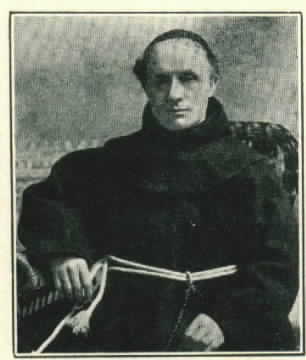 It is only just and fair that we pay a small tribute of gratitude to this pioneer priest of the Franciscan Order of Wisconsin.* All the grown-ups in Northeim certainly still do remember "Father Jerome" as he was usually called. As early as the spring of 1906, Father Jerome's name appears on the Parish Books. When there was no resident priest in Northeim, his countrymen at Northeim could always count on his helping hand. He came and stayed over the weekends so as to accommodate the parishioners with Sunday services. Bishop Fox of Green Bay gave him all the faculties of the Diocese at large so that he could be had at Northeim whenever needed. He liked the people out here, and the people simply loved him. He spoke Polish, French, and German well, and for this reason could accommodate all the people. Although an old man of some 65 years already at that time, he lived to the ripe age of ninety-five when he died on March 28, 1937, always active in the holy priesthood. In his later years, when freed from all duties at the monastery in Pulaski, he often stayed all alone in the rectory at Northeim, getting his meals at the nearest neighbors. And although later on he carried already the eightieth year on his shoulders, yet he was still able to sing a High Mass and preach. His name even today is repeated with reverence and gratitude. * (One of the three first pioneers and organizers of the Franciscan establishment at Pulaski, Wis. Nominated Provincial Superior for several terms, and afterwards relieved from all duties in the monastery, he gladly replaced pastors and filled vacancies in the nearby parishes of the Green Bay Diocese.) REVEREND IGNACE PALUCH 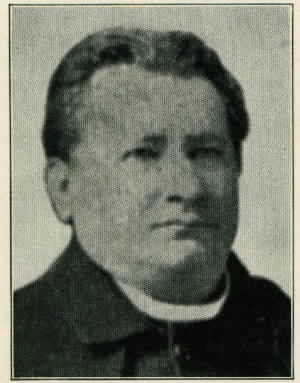 In May 1893, the Rev. Ignace Paluch took charge of the congregation. His signature appears for the first time in the Baptismal Records, June 4, 1893. His administration of this parish was the longest duration of all the pastors up to this date. Father Paluch was born in Galicia, Austria. He completed his studies for the priesthood at Lemberg (Lwow), and had been also ordained there. In 1893 he came to America, where he was engaged in the sacred ministry as assistant priest for a short time. In May, 1893, he received the appointment as pastor of Northeim. Here he labored for twelve years. His aspiration, however, was to return to this native country, Poland. After making some preparations to do so, death suddenly came to him. His mortal remains are resting aside of the large Cross at the parish cemetery at Northeim. A simple concrete monument marks his grave. No special historical details, however, could be pieced together in order to perpetuate his longest pastorate at Northeim. * * (The dates are taken from "The Catholic Church in Wisconsin", p. 493; the other details from the Parish records.) REVEREND STANISLAUS LAPINSKI * * (Father Lapinski opens a new period in the History of St. Casimir's Congregation at Northeim. With him a series of newly ordained priests for the Diocese of Green Bay begins. Many of the subsequent historical details up to the present day could be more easily pieced together from the various Church Records and from a personal contact with the former pastor.) 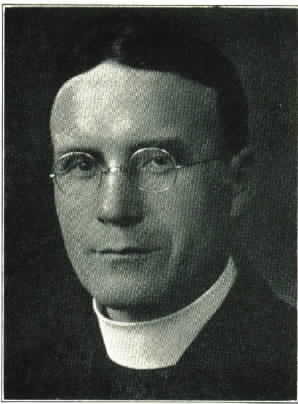 Father Lapinski had completed his course of studies for the priesthood at SS. Cyril and Methodius Seminary, Orchard Lake, Michigan, and was ordained on August 15, 1914, at St. Joseph Orphanage, Green Bay, Wisconsin. In the first days of September, 1914, Father Lapinski was appointed as quasi-assistant to St. Mary's parish in Manitowoc, and at the same time pastor of St. Casimir's parish in Northeim, thus performing the duties of an assistant at St. Mary's, and discharging pastoral duties at Northeim, a combination which did not do justice to either place. He lodged and resided, however, in St. Mary's rectory, in Manitowoc. Twice a week, he traveled by train to Northeim in order to celebrate Mass there, and also to take care of the catechetical instructions of the children. On Sunday mornings, when there was no transportation by train, he had to resort to horse and buggy, in order to be on time for Sunday services. Some months later he became a resident pastor. Father Lapinski remained in charge of this parish until May 16, 1916. Although his pastorate lasted only eighteen months, yet many improvements had been made during his sojourn here. During his time, new colored windows were installed in the church. The sanctuary floor had been covered with new carpeting. New furniture had been purchased for the rectory. Many other minor improvements within the church and around the premises were also made. In May, 1916, Father Lapinski was transferred to St. Bartholomew's parish, Mill Creek, Wis., and since 1939, he is in charge of St. Mary's parish, Fancher, Wisconsin. REVEREND IGNACE GRAD 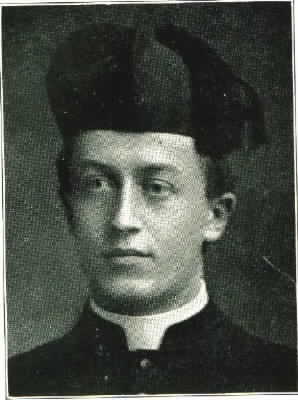 The Rev. Ignace Grad was born in Poland. He began his studies for the priesthood in his native land. Coming to this country, he entered St. Francis Seminary, Milwaukee, Wisconsin, and completed his theological studies there. He was ordained by Bishop J.J. Fox, in St. Francis Cathedral, Green Bay, Wis., on April 14, 1914. He was first assigned as an assistant to St. John's parish, Antigo, Wis. From there, he served as pastor at St. Joan of Arc parish, of Goodman, Wis., when he was transferred to St. Casimir's parish of Northeim, on November 19, 1916. During his stay here, some improvements and purchases were made. A long needed cement sidewalk, leading from the main road to the church, was constructed by the hands of the parishioners, thus saving the extra expense on labor. Aside from this, it is in place and time to credit and recognize the noble and charitable deeds of Father Grad and the good people of Northeim. They contributed generously to the Polish Campaign Fund in behalf of the war-sufferers in Poland, conducted throughout this country during the First World War. Through his initiative, the results were astonishing. According to a newspaper clipping, found in the rectory office, a sum of $923.00 was collected for that purpose. At a later date, that is in October 1919, Father Grad was appointed pastor of St. Mary's parish at Torun, Wisconsin. REVEREND PETER NOVITSKE * * (No photograph available) Born at Eaton, Brown County, Wisconsin, Father Novitske attended St. Francis Seminary and was ordained by the Most Rev. Bishop P.P. Rhode, in the Cathedral of Green Bay, June 16, 1917. On October 20, 1919, he was appointed pastor of Northeim. He erected a combination building containing a garage, shed and chicken coop, and also some purchases for the rectory. On April 20, 1921, Father Novitske received his appointment as pastor of Holy Trinity church, at Pine Grove, Wis. Presently he is pastor of St. Mary's parish, at Torun, Wisconsin. REVEREND DOMINIC SZOPINSKI 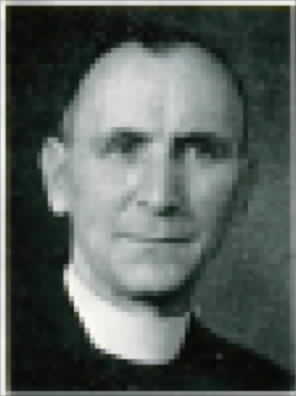 Finishing his theological course at St. Francis Seminary, Milwaukee, Wis., Father Szopinski was ordained in May 1907. For one year, Father Szopinski worked in the Archdiocese of Chicago. Then he was appointed professor at St. Francis Seminary where he stayed until the end of June 1921. On Sept. 22, 1921, Father Szopinski received his appointment as pastor of St. Casimir's parish at Northeim. His pastoral work at Northeim is marked with much success and reminiscences. During his seven years' administration much was accomplished both to the material and spiritual needs of the parish. The old school house was remodeled so as to offer catechetical instructions and a winter-chapel, at a cost of $400.83. A furnace was installed in the church and another one in the rectory, thus doing away with the ordinary stove heating. During the summer months of 1925, the church was redecorated and some other necessary improvements and changes made at a cost of $1,740.00. The following year a Delco Electric plant was installed at a cost of $346.36. The last financial report of 1927, issued just shortly before the transfer of Father Szopinski shows that there was a balance of $462.08 left in the parish treasury, all bills paid. All the above figures speak for themselves. They portray to the reader the usual activity of Father Szopinski and the great spirit of making such astonishing offerings by the devoted people of this parish. In January 1928, Father Szopinski was transferred as pastor to Peshtigo, Wis. The parishioners were greatly grieved to bid him farewell. Since 1938, he is in charge of St. Anthony's parish, Niagara, Wisconsin. REVEREND FLORIAN MARMUROWICZ 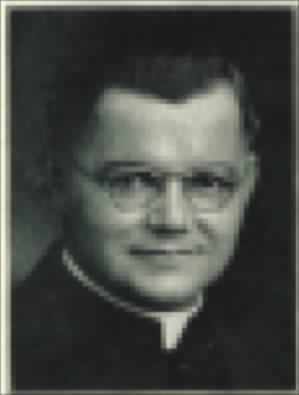 Born in Poland, Europe, Father Marmurowicz came as a boy with his parents to this country in 1903, and stayed with them in Milwaukee, Wis. He completed a course of philosophy and theology at SS. Cyril and Methodius Seminary, Orchard Lake, Michigan and was ordained by the Most Reverend Bishop P. P. Rhode, at the cathedral in Green Bay, on May 20, 1926. Father Marmurowicz received his appointment as pastor of Northeim in January 1928. His stay at Northeim, however, was of a brief duration, namely some four months. At present Father Marmurowicz is pastor of St. Michael's parish, Junction City, Wis. * * * * After the transfer of Father Marmurowicz, we find the congregation at Northeim in charge of a Franciscan Father from Pulaski, Wis., the Rev. Benedict Witkowski, who acted as a substitute for the time being until the appointment of a steady pastor. REVEREND P. SOKOL * * ( No photograph available) Father Sokol was pastor for the second time at Northeim, but for a short duration only. According to the Records, Father Sokol was previously appointed pastor of Northeim on March 13, 1910, and stayed until April 30, 1911. Very little is known of him from the time he left Northeim after his second sojourn here. Most likely he spent the remaining years on a health cure at San Antonio, Texas, where he died on Jan. 7, 1943. REVEREND JOSEPH WEISS * * (No photograph available) According to the Baptismal Records of the parish, the Rev. Joseph Weiss acted as pastor of Northeim in January, 1929. Many improvements and purchases were made during his administration. The rectory was completely remodeled, repaired and furnished at a cost of $1,762.12, a part of which sum was paid by the congregation, and the balance of $1,017.98 as expenditure for installing a complete Kohler bathroom with an inlaid linoleum was solicited by Father Weiss by way of donations from various concerns and businessmen in the vicinity. During his time, the High Power Line came through, thus requiring a change in the electric equipment heretofore used on the church premises. From the Records it appears that fixtures for the church were purchased for $145.53. Father Weiss left this parish in August, 1931. REVEREND MICHAEL WASNIEWSKI 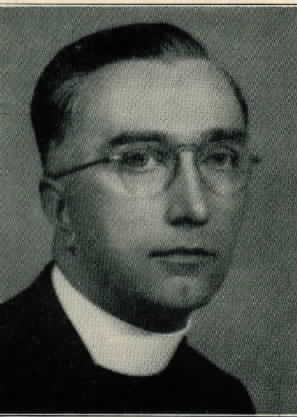 Father Michael succeeded Father Weiss in the latter part of 1931. Father Wasniewski's home town is the city of Milwaukee. He was ordained by Bishop P.P. Rhode for the Diocese of Green Bay. His first appointment was that of an assistant pastor at St. Mary's in Manitowoc. After a brief stay, he was transferred as an assistant to St. Peter's church, Stevens Point. In the fall of the same year, he received his appointment as pastor of Northeim. Due to the prevailing depression and small number of families, Father Wasniewski met with some financial difficulties. Many items had to be purchased both for the church and the rectory; some minor repairs also had to be made. Aside from the purchases, he received many donations in the form of an altar and church supplies by his personal efforts. Father Wasniewski had left behind himself a perpetual reminiscence by having the parish cemetery completely rearranged, planning it into lots and sections; rearranging the various monuments and grave-markers, and leveling the entire surface in order to give it shape and symmetry, for which the parishioners and those visiting their deceased friends are grateful to him. In April 1934, he was transferred to Holy Trinity parish at Pine Grove, where he is still pastor. REVEREND STANISLAUS ZIOLKOWSKI * * (No photograph available) Born in Chicago, Illinois, Father Ziolkowski was ordained by the Most Rev. Bishop P.P. Rhode, in the Cathedral of Green Bay, June 7, 1922. His first appointment was that of an assistant at St. Peter's church Stevens Point, Wis. After performing pastoral duties in several parishes of the Diocese, he was transferred from Pine Grove to St. Casimir's of Northeim, in April 1934. As his predecessor, so in like manner Father Ziolkowski was confronted with financial difficulties of the parish. The financial report of January 1, 1934, just shortly before his arrival here, shows total liabilities of $1,100.81. (NOTE) This is the first time that the old Records of this parish show liabilities against St. Casimir's congregation amounting to such a figure. Undismayed, he managed to carry the congregation through the hard times then prevailing in this country without contracting new debts; on the contrary, he managed to pay cash for all items purchased during each year, and above that also paid off the principal, reducing it to $625.00. Of course, several necessary purchases, repairs and improvements had to be made. A new furnace was installed in the rectory; the old roof on the house was replaced; the living room was repainted and furnished with a new rug. In October, 1937, Father Ziolkowski was transferred from here to St. Hedwig's parish, Kewaunee, Wisconsin. He was succeeded by Father Grad for the second time. REVEREND ANTHONY BETLEY Present Pastor Born in the year 1909, in Sobieski, Wis., after having completed the required grades in the local public school in his District, he entered St. Bonaventure High School, then located in Pulaski, Wis. In 1927, he graduated with one year of classics from St. Bonaventure's college at Sturtevant, Wis. In the fall of 1927, he enrolled as a college student at St. Mary's College, Orchard Lake, Michigan. Upon completing there his second year of classics, he received the B.A. degree. He made his philosophical and theological course at SS. Cyril and Methodius Seminary, Orchard Lake, Mich., and was ordained by the Most Rev. Bishop P.P. Rhode at St. Francis Xavier Cathedral, May 26, 1934. On June 15, 1934, he was appointed as assistant to Father Pociecha at St. Mary's church, Manitowoc. On March 12, 1936, he was appointed administrator of St. Adalbert's parish in Rosholt, Wis., the pastor then being the Rev. Michael Klosowski who was incapacitated due to illness. In May 1937, he was transferred as assistant to St. Peter's parish, and on June 15, 1939, to Northeim. PROMINENT PERSONS WHO CLAIM NORTHEIM AS THEIR BIRTHPLACE OR PLACE OF RESIDENCE Reverend John F. Szukalski 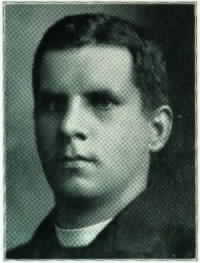 Born in Poland (Prussia), March 8, 1863, he came to America in 1868 with his parents, who settled in Northeim. In the year 1879 he entered St. Francis Seminary, Milwaukee, for the studies to the priesthood. Ordained June 24, 1888, Father Szukalski was appointed as pastor of St. Michael's parish in Beaver Dam, Wis. From there he was transferred to Milwaukee in 1893, to organize SS. Cyril and Methodius parish, where he labored until his death, which occurred April 7, 1915.
|